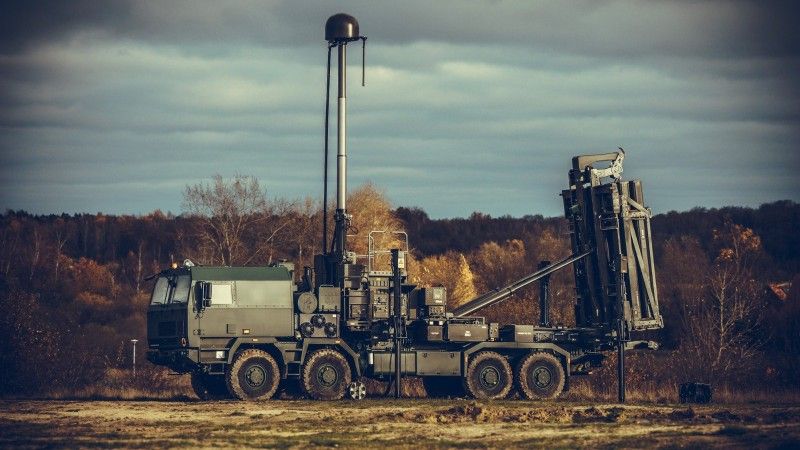Armed Forces
Polish “Iron Division” Leading the Air Defence Revolution

Photo. St. szer. Sławomir Kozioł/18 DZ
The soldiers of the 18th Mechanized Division are currently taking part in an exercise at the training range in Ustka. They are operating the recently commissioned “Little Narew” air defence system based around the CAMM SAM systems.
The training exercise at the Air Force Training Range in Ustka involves soldiers hailing from the newly formed 18th Air Defence Regiment (Zamość-Sitaniec), which is also a part of the "Iron Division". Those soldiers operate the "Little Narew" system that includes CAMM launchers based on the Jelcz 8x8 trucks, using the Soła radars, and a C2 system developed domestically, in Poland.
The Air Force is also involved in the exercise taking place in Ustka, with its F-16 jets, probably in the red-air role. Apart from them, representatives of the Polish and British defence industries also participate in the undertaken activities. Considering the fact that we are dealing with the first system of the kind (of such performance in general), operated by the Polish Armed Forces, not only would the training be aimed at preparing the crews to handle such assets, but also at developing and perfecting the procedural framework for the use of such a system. The experience gathered during that exercise would be precious both for the air defence specialists, and the pilots for instance.
Na poligonie w Ustce trwa szkolenie specjalistyczne obsług baterii systemu „Mała Narew” z 18. Pułku Przeciwlotniczego z Zamościa. Szkolenie prowadzone jest z udziałem lotnictwa Sił Powietrznych oraz inżynierów z polskiego i brytyjskiego przemysłu obronnego. pic.twitter.com/TZCayL9ied
— 18 Dywizja Zmechanizowana (@Zelazna_Dywizja) November 17, 2022
We are referring to an air defence system that offers the capability to engage multiple targets at once, using ARH missiles. Each missile only requires a preliminary target data set, and then that data could be potentially updated. In the terminal phase of engagement, the guidance system is self-sufficient, there is no necessity to track the target with the use of the fire control radar. Kub, Osa, Newa-SC, and Wega systems operated by the Polish Army so far, as well as the Standard SM-1MR system operated by the Polish Navy (OHP Frigates), have been using either semi-active radar seekers or the command guidance, meaning that throughout the whole engagement the missile had to receive data from the air defence system, or the target had to be tracked by the SAM system's radar.
The "Little Narew" may thus be used to act against massive airstrikes even when a single fire unit is deployed, with a maximum range defined as more than 25 kilometres. Reaction time or missile kinematics also exceed those of the legacy systems. The "Little Narew" has been configured rapidly, as an existing radar, and modified C2 elements were used to build it. Thus, the system could have been delivered in October this year, following the order placed in April. Training is a part of the natural course of events, as the user follows a proper path of preparing the system for operational use. Again, this needs to be reiterated: "Little Narew" is the first system of this kind in Poland. The system has been delivered by a PGZ consortium, while the missiles have been supplied by MBDA UK.

Another example of this system is to be handed off to the 15th Air Defence Regiment from Gołdap. Let us add that the experiences gathered throughout the "Little Narew" programme have resulted in a decision to create a Polish-made Pilica+ system, in which a modernized C2 system of the combined Pilica AAA/SAM solution would also be integrated with the CAMM launchers, and new Bystra radars, being the first Polish AESA sensors. Systems as such would be used to defend and protect the Patriot MRAD assets, as a part of a holistic IADS.
Read more
Meanwhile, the Narew system in its final form integrated within the IBCS network, and with the Sajna radars that would offer a broader set of target detection capabilities, is to be armed with the license-manufactured CAMM-ER missiles, offering a range extended to 45 kilometres. Ultimately that system would also be complemented with a CAMM-MR missile, jointly developed by the Polish and British industries, offering an even more expanded performance envelope. In total, 21 Pilica+, and at least 23 Narew batteries in their final configuration are to be commissioned. It remains an open question whether further procurement would be planned, as extra divisions are established.
But this is a matter that is placed further down the timeline. Currently, the operational practice related to the first version of the system needs to be perfected. The commissioning of the "Little Narew" is a necessary step. Rearming the Polish GBAD (apart from the VSHORAD assets) with western systems (Wisła and Narew), replacing those whose heritage is rooted in the Soviet Union would be time-consuming. The establishment of new units is planned to happen as well.

